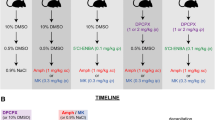Abstract
Mice with a 6-hydroxydopamine induced unilateral nigro-striatal lesion received (+)-amphetamine sulphate (2.5–20 mg/kg) over a 3-month period by daily incorporation into the drinking water. During this period the circling response to apomorphine hydrochloride (0.01–0.5 mg/kg, s.c.) was increasingly suppressed in comparison to control animals, while spontaneous locomotor activity increased. Following drug withdrawal the circling response to apomorphine remained suppressed two months later. However, spontaneous locomotor activity was also reduced up to 1 month following drug removal.
The dopamine content of the lesioned side of the forebrain was 25% of the intact side in control animals and was not further reduced by amphetamine administration. The dopamine content of the intact forebrain was reduced by 43% during amphetamine administration and remained 18% depressed 1 month following drug withdrawal. No changes in 5-hydroxytryptamine or noradrenaline concentrations were observed in either the intact or lesioned side.
This data, while showing that chronic amphetamine treatment can induce persistent changes in dopamine receptor sensitivity, can be interpreted in terms of increased striatal receptor sensitivity or as a decreased response of dopamine receptors in the nucleus accumbens.
Similar content being viewed by others
References
Angrist, B. M., gershon, S.: The phenomenology of experimentally induced amphetamine psychosis-preliminary observations. Biol. Psychiatry 2, 95–107 (1970)
Angrist, B. M., Shopson, B, Gershon, S.: Comparative psychotomimetic effects of stereoisomers of amphetamine. Nature 234, 152–153 (1971)
Chang, C. C.: A sensitive method for spectrofluorimetric assay of catecholamines. Int. J. Neuropharmacol. 3, 643–649 (1964)
Clay, G. A., Cho, A. K., Roberfroid, M.: Effect of diethylaminoethyldiphenylpropylacetate hydrochloride (SKF-525A) on the norepinephrine-depleting actions of amphetamine. Biochem. Pharmacol. 20, 1821–1831 (1971)
Creese, I., Iversen, S. D.: The role of forebrain dopamine systems in amphetamine induced stereotyped behaviour in the rat. Psychopharmacologia (Berl.) 39, 345–357 (1974)
Curzon, G., Green, A. R.: Rapid method for the determination of 5-hydroxytryptamine and 5-hydroxyindoleacetic acid in small regions of rat brain. Br. J. Pharmacol. 39, 653–655, (1970)
Ellinwood, E. H. Jr., Judilovsky, A., Nelson, L. M.: Evolving behaviour in the clinical and experimental amphetamine (model) psychosis. Am. J. Psychiatry 130, 1088–1093 (1973)
Freeman, J. J., Sulser, F.: Imprindole-amphetamine interactions in the rat: the role of aromatic hydroxylation of amphetamine in its mode of action. J. Pharmacol. Exp. Ther. 183, 307–315 (1972)
Griffin, J. D., Cavanagh, J. H., Held, J., Oates, J. A.: Experimental psychosis induced by the administration of d-amphetamine. In: Amphetamines and related compounds, proceedings of the Mario Negri Institute for Pharmacological Research, Milan, Italy, E. Costa and S. Garattini, eds., pp 897–904 New York: Raven 1970
Kelly, P., Moore, K. E.: Mesolimbic dopaminergic neurones in the rotational model of nigrostriatal function. Nature 263:695–696 (1976)
Klawans, H. L., Margolin, D. I., Dana, N., Grosset, P.: Supersensitivity to d-amphetamine- and apomorphine-induced stereotyped behaviour induced by chronic d-amphetamine administration. J. Neurol. Sci. 26, 283–289 (1975)
Kogan, F. I., Nichols, W. K., Gibb, J. W.: Influence of methamphetamine on nigral and striatal tyrosine hydroxylase activity and on striatal dopamine levels. Eur J. Pharmacol. 36, 363–371 (1976)
Laverty, R, Sharman, D. F.: The estimation of small quantities of 3,4-dihydroxyphenylalanine in tissues. Br. J. Pharmacol 24, 538–548 (1965)
Lewander T.: A mechanism for the development of tolerance to amphetamine in rats. Psychopharmacologia (Berl) 21, 17–31 (1971)
Pycock, C., Marsden, C. D.: The rotating rodent: a two component system. Eur. J. Pharmac. 47, 167–175 (1978)
Pycock, C. J., Jenner, P. G., Marsden, C. D.: The interaction of clonidine with dopamine-dependent behaviour in rodents. Naunyn-Schmiedeberg's Arch. Pharmacol 297, 133–141 (1977)
Pycock, C., Tarsy, D., Marsden, C. D.: Inhibition of circling behaviour by neuroleptic drugs in mice with unilateral 6-hydroxydopamine lesions of the striatum. Psychopharmacologia (Berl.) 45, 211–219 (1975)
Randrup, A., Munkvad, I.: Biochemical anatomical and psychological investigations of stereotyped behaviour induced by amphetamines. In: Amphetamines and related compounds, proceedings of the Mario Negri Institute for Pharmacological Research, Milan, Italy, E. Costa and S. Garattini, eds.), pp. 695–713 New York: Raven 1970
Rebec, G. V., Groves, P. M.: Enhancement of effects of dopaminergic agonists on neuronal activity in the caudate-putamen of the rat following long-term d-amphetamine administration. Pharmacol. Biochem. Behav. 5, 349–357 (1976)
Segal, D. S., Mandell, A. J.: Long-term administration of d-amphetamine: progressive augmentation of motor activity and stereotypy. Pharmacol. Biochem. Behav. 2, 249–255 (1974)
Sever, P. S.: Receptor sensitivity in schizophrenia. Lancet 1976I, 312
Sever, P. S., Caldwell, J., Williams R. T.: Tolerance to amphetamine in two species (rat and guinea pig) that metabolize it differently. Psychol. Med. 6, 35–42 (1976)
Snyder, S. H.: Amphetamine psychosis: a ‘nodel’ of schizophrenia mediated by catecholamines. Am. J. Psychiatry 130, 61–67 (1973)
Taylor, K. M., Snyder, S. H.: Differential effects of d- and l-amphetamine on behaviour and on catecholamine disposition of dopamine and norepinephrine containing neurones of rat brain. Brain Res. 28, 295–309 (1971)
Thesleff, S.: Effects of motor innervation on the chemical sensitivity of skeletal muscle. Physiol. Rev. 40, 734–752 (1960)
Trendelenburg, U.: Mechanism of supersensitivity and subsensitivity to sympathomimetic amines. Pharmacol. Rev. 18, 629–640 (1966)
Ungerstedt, U.: Post-synaptic supersensitivity after 6-hydroxydopamine-induced degeneration of the nigro-striatal dopamine system. Acta Physiol. Scand. [Suppl. 367] 82, 69–93 (1971)
von Voigtlander, P. F., Moore, K. E.: Turning behaviour of mice with unilateral 6-hydroxydopamine lesions in the striatum; effects of apomorphine, l-dopa, amantadine amphetamine and other psychomotor stimulants. Neuropharmacology 12, 451–462 (1973)
Author information
Authors and Affiliations
Rights and permissions
About this article
Cite this article
Jenner, P., Pycock, C. & Marsden, C.D. The effect of chronic administration and withdrawal of amphetamine on cerebral dopamine receptor sensitivity. Psychopharmacology 58, 131–136 (1978). https://doi.org/10.1007/BF00426895
Received:
Issue Date:
DOI: https://doi.org/10.1007/BF00426895




